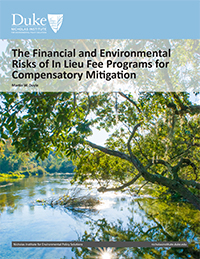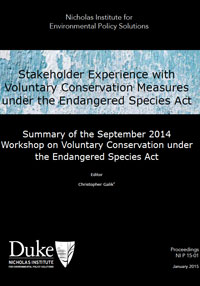Publications
The Financial and Environmental Risks of In Lieu Fee Programs for Compensatory Mitigation
This is a review of a sample of In Lieu Fee (ILF) Programs through an analysis of general incentives created by the ILF Program model, and through drawing on a small sample of ILF Programs as case studies. This review focuses on the incentives created by ILF Programs as a mechanism of compensatory mitigation; while other forms of compensatory mitigation—permittee-responsible mitigation and mitigation banking—are not without their problems, there are intrinsic financial and environmental risks that are unique to ILF Programs. The insights gained from this limited review also demonstrate the need for a systematic review of ILF Programs across the U.S., particularly (a) consistency of CWA ILF Programs since the implementation of the 2008 Mitigation Rule, and (b) emerging ESA ILF Programs and their divergence from best practice principles present in the 2008 Mitigation Rule.
Assessing County and Regional Habitat Conservation Plan Creation: What Contributes to Success?
Habitat conservation plans (HCPs) are a means for private landowners to comply with the Endangered Species Act. It has become increasingly common for county and regional governments to create region-wide HCPs that cover development from multiple projects in the entire region. Local governments recognize that these plans can increase economic certainty for residents, increase development, and potentially increase conservation. However, region-wide plans are time and resource intensive, and they sometimes are not completed. What factors and processes lead to the successful completion of an HCP at the regional and county level? This paper presents the results of five case studies on county or regional HCPs. It finds that several factors contribute to successful HCP creation: (1) a cooperative relationship between the county or region and the U.S. Fish and Wildlife Service (USFWS) and between the local governing body and the USFWS; (2) local community and political involvement, especially early stakeholder engagement; (3) determination of the covered species by a scientific advisory committee or a consultant; (4) primary funding through USFWS Section 6 grants; and (5) utilization of the county or region’s own reserve lands to most efficiently use mitigation funds and provide the best species habitat. By identifying these factors that contribute to HCP success, this analysis allows stakeholders to anticipate needs and potential barriers, benefitting individuals with diverse interests in counties and regions where a large-scale HCP is possible.
Authors: Chelsea L. Baldino, Lydia P. Olander, and Christopher S. Galik
Researching a Reimagined ESA: The Continued Need and Opportunity for Voluntary Conservation
Since passage of the U.S. Endangered Species Act (ESA) more than 40 years ago, federal agencies have sought to enhance the engagement of non-federal landowners and managers in recovery actions. An effort to design programs and policies to facilitate voluntary conservation activities under the ESA has been renewed, but the adoption and effectiveness of these activities could be diminished by the lack of data to address three issues. First, landowners and land managers must be motivated to participate in pre-listing and voluntary conservation and to do so at the scale necessary to achieve conservation outcomes. Second, activities need to be effective in promoting conservation. Third, laws and administrative processes must accommodate or facilitate desired approaches. This working paper identifies data needs in each of these three areas, reviews experience with existing voluntary conservation approaches under the ESA, and recommends research and implementation strategies to make voluntary conservation approaches more widespread.
Stakeholder Experience with Voluntary Conservation Measures under the Endangered Species Act
On September 26, 2014, the Nicholas Institute for Environmental Policy Solutions at Duke University, with funding from the Oak Ridge Associated Universities consortium, convened a half-day meeting in Washington, D.C., at which representatives from private and federal organizations as well as leading ESA researchers discussed stakeholders’ experience with voluntary conservation measures under the Endangered Species Act, data gaps that preclude more widespread implementation of such activities, and research activities necessary to contribute new and vital information. The primary insights from the meeting are that experience with existing voluntary conservation tools under the Endangered Species Act provides a basis for the design of new approaches and that the design process requires a solid foundation of legal, institutional, economic, and empirical, field-based information.
Carbon Offsets and Environmental Impacts: NEPA, the Endangered Species Act, and Federal Climate Policy
Carbon offsets have been an integral part of recent climate policy proposals, but there are questions about how a carbon offsets program would interact with existing environmental laws. Laws such as the National Environmental Policy Act (NEPA) and the Endangered Species Act (ESA) require federal agencies to assess the potential impacts their actions would have on the environment. Such assessments can be lengthy and time consuming, and they could delay the establishment of an offsets program or the approval of individual projects. This paper examines how the type of offsets program proposed in recent climate legislation would be affected by the requirements of NEPA and the ESA. The authors suggest a range of policy options that would allow an offsets program to address any potential conflicts with these laws, while still meeting their requirements.





